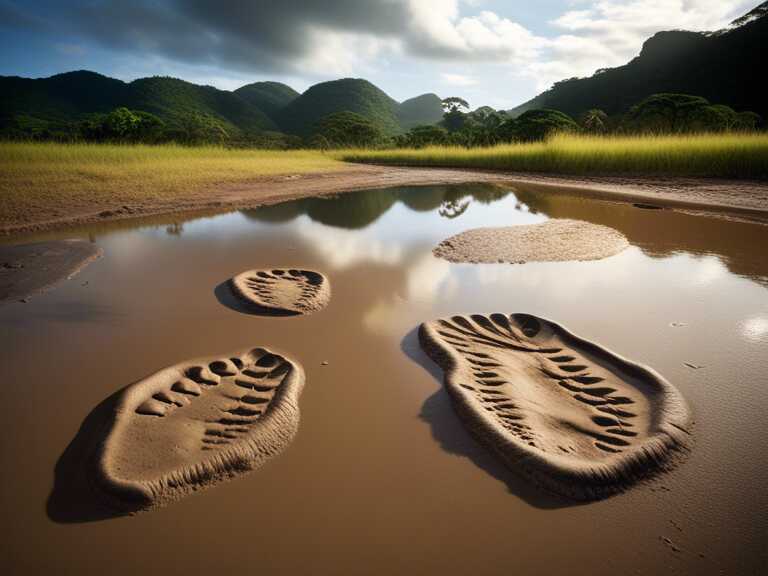
Dinosaur Footprints Found in Brazil and Cameroon Reveal Ancient Connection Between South America and Africa
Matching dinosaur footprints found in Brazil and Cameroon show land-dwelling dinosaurs crossed between South America and Africa before they split apart.

A groundbreaking discovery along two diverse continents reveals the ancient migration of land-dwelling dinosaurs, demonstrating the significance of these findings in understanding the prehistoric world.
Discovery of Matching Footprints
Recently, a team of paleontologists unveiled an astonishingfind: matching dinosaur footprints located on two disparate continents, separated by vast oceanic expanses. These footprints, dating back to the Early Cretaceous period, were unearthed in Brazil and Cameroon, shedding light on a time when land-dwelling dinosaurs roamed freely between South America and Africa before the continents diverged millions of years ago, according to a study published by the New Mexico Museum of Natural History & Science.
An Unprecedented Connection
The significance of this find cannot be overstated. The footprints, engraved into mud and silt along ancient rivers and lakes, were discovered over a staggering distance of more than 3,700 miles, with one site in South America and the other in Africa. Researchers found that despite the immense geographical separation, the footprints shared striking similarities in age, shape, and geological and plate tectonic contexts. Louis Jacobs, a paleontologist from Southern Methodist University and the study's lead author, emphasized that these tracks date back 120 million years to a time when the two continents were part of a single supercontinent called Gondwana, which had already broken off from the larger landmass of Pangea, the sole continent on Earth at that time.
The Elbow of Northeast Brazil
"One of the youngest and narrowest geological connections between Africa and South America was the elbow of northeastern Brazil nestled against what is now the coast of Cameroon along the Gulf of Guinea," Jacobs explained. "The two continents were continuous along that narrow stretch, so that animals on either side of that connection could potentially move across it."
The Splitting Continents
The researchers assert that the continents as we know them today, Africa and South America, began their separation around 140 million years ago. The void created by their divergence eventually evolved into the South Atlantic Ocean, leading to the formation of basins, rivers, and lakes in the process. Interestingly, the basins where the dinosaur footprints were found are situated on both sides of this geological split, further supporting the historical significance of the discovery.
The Dinosaurs of the Era
The findings provide valuable insights into the types of dinosaurs that once roamed these ancient landscapes. The majority of the footprints were attributed to three-toed theropods, a group of carnivorous dinosaurs, while prints from sauropods and ornithischians were also identified. Jacobs highlighted the ecological context, stating, "Plants fed the herbivores and supported a food chain. Muddy sediments left by the rivers and lakes contain dinosaur footprints, including those of meat-eaters, documenting that these river valleys could provide specific avenues for life to travel across the continents 120 million years ago."
The Pathway of Discovery
This groundbreaking research not only deepens our understanding of the vast expanses these ancient reptiles traversed but also provides invaluable insights into the interconnectedness of prehistoric ecosystems. The ancient landscapes of Brazil and Cameroon once provided a shared habitat for a diverse range of dinosaurs, challenging our perception of geographical barriers and highlighting the adaptive capabilities of these remarkable creatures.
The Implications of the Discovery
The implications of this discovery extend beyond the scientific realm; they evoke a sense of awe for the interconnectedness of prehistoric life across vast distances. It prompts us to rethink the limitations that we often attribute to ancient species, showcasing their ability to navigate and inhabit regions that were once thought to be insurmountably separated by geological events.
A Collaborative Effort
Aliza Chasan, a Digital Content Producer for "60 Minutes" and CBSNews.com, emphasizes that such groundbreaking discoveries are the result of collaborative efforts and extensive fieldwork undertaken by dedicated researchers. The findings underscore the importance of continued exploration and analysis of ancient ecosystems to unlock the secrets of our planet's prehistoric past.
Share news















